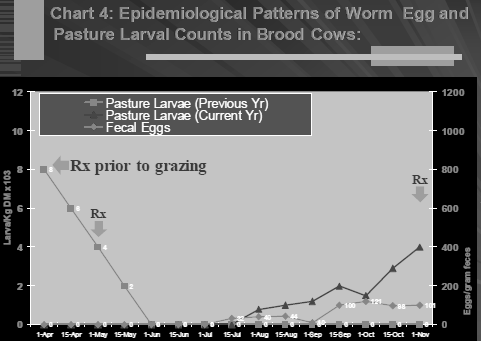Internal parasites can cause significant decreases in productivity in both beef and dairy operations. Instituting a timely and effective deworming schedule will keep cattle healthier and increase profitability.
Safe-Guard is a highly effective dewormer that can be fed at the bunk or dosed orally. It works against several types of worms and, with a variety of forms available, it can easily be incorporated on to most cattle operations. At Famo Feeds, we manufacture Safe-Guard pellets which can conveniently be fed as a single day deworming treatment.
When to Deworm
| DEWORMING SCHEDULE | |
|---|---|
| BEEF | |
| Cow/Calf Operations | Fall: Deworm cattle as they are moved off pasture at the end of grazing season (Typically around Thanksgiving).
Spring: Deworm cattle if they were not dewormed in fall at turnout. If fall deworming occurred, deworm cattle 6-8 weeks after spring grazing commences (typically around Memorial Day/4th of July). |
| Stocker Cattle | Deworm cattle at turnout followed by a second treatment 3-4 weeks later and a third treatment 3-4 weeks after that. |
| Feedlot Operations | Cattle with positive fecal egg counts should be dewormed at arrival. |
| DAIRY | |
| Cows | Dairy cattle with exposure to parasites through pastures or contaminated lots should be treated. Individual cows that have moderate to high parasite levels should be dewormed at freshening and again 6 weeks later. Cows that are seasonally grazed should be dewormed late fall and then again 6 weeks after turnout the following spring. |
| Heifers | Grazing heifers should be treated at turn out, and again 3-4 and 7-8 weeks later |

Why Bother with Strategic Deworming?
Chart 4 shows the importance of strategic deworming. Fall deworming alleviates any buildup of intestinal parasites that have accumulated over the grazing season as cattle are moved off pasture. Spring pasture deworming prevents worm infestation from larvae that have survived on pasture from the previous year. Spring pasture deworming also kills maturing worms before they lay eggs and reinfect the pasture helping reduce late season exposure.
Impacts to Beef Production
Deworming is a necessary procedure in raising cattle. Internal parasites can cost beef producers anywhere from $20 – $200 per head. Internal parasites reduce feed intake, thus decreasing weight gain and efficiency, and also impair the calf’s immune system. By affecting the immune system, it reduces the animal’s response to vaccines, reducing their efficacy.
Mississippi Study
A trial was conducted using crossbred steers housed on 2 matching 400 acre segments. The deworming treatments tested were:
- an injectable, long-acting eprinomectin
- a Safe-Guard drench and generic ivermectin pour on. This group also received Safe-Guard Dewormer Range Cubes on days 28 and 56
The results are summarized below:
| Pasture Group | Treatment | Head Count | Start Weight | End Weight | Gain | Days Grazing | Averag Daily Gain |
|---|---|---|---|---|---|---|---|
| North | Long-acting eprinomectin | 235 | 626 | 796 | 170 | 132 | 1.29 |
| South | Safe-Guard & ivermectin | 242 | 624 | 817 | 193 | 124 | 1.56 |
Using a Oklahoma City-based average price of $2.30/lb for 7 to 8 weight steers (quoted 9/2014), the extra 23 lbs gained by the South group translated into an extra $52.90/head or $12,801.80 for all 242 steers. Besides the increases in gain, the combination treatment of Safe-Guard and ivermectin along with the range cubes costs 20% less than the long acting eprinomectin. Each steer gained 23 lbs more and it cost 20% less!
Effects on Dairy Cattle
Dairy cows managed on grazing programs may become parasitized. As much as 6 lbs of milk can be lost per cow per day when dairy cattle struggle with internal parasitism. For 100 head of cattle that’s 600 lbs of milk/day that is lost. Though deworming comes at a cost, that cost is significantly less than the production loss due to internal parasites.
Dairy heifers benefit from deworming with better average daily gains allowing them to reach breeding size earlier (see below):
| Location | # of heifers | Deworming program (weeks)* | Weight gain vs. Controls | Time to breeding size |
|---|---|---|---|---|
| Minnesota | 539 | 0-4-8 | +107 lb | 68 days earlier |
| Vermont | 60 | 0-3-7 | +38 lb | >28 days earlier |
| Virginia | 18 | 0-3-6 | +60 lb | 58 days earlier |
| Wisconsin | 45 | None**-4-8 | +44 lb | 35 days earlier |
*heifers treated with Safe-Guard. Refers to weeks relative to turnout on pasture.
**heifers weighed less than 400 lb at turnout so no initial treatment was given.
Are Worms Eating Your Profits?

